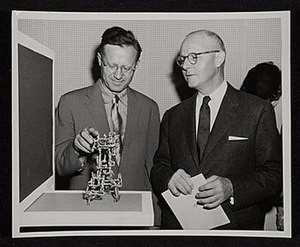Ibram Lassaw | |
|---|---|
 Ibram Lassaw and Charles C. Withers, 1955 Sep 13 / unidentified photographer.
American Federation of Arts records,
Archives of American Art, Smithsonian Institution. | |
| Born | May 4, 1913 |
| Died | December 30, 2003 (aged 90) |
| Nationality | American |
| Education | The Clay Club, City College of New York, Beaux-Arts Institute of Design |
| Known for | Sculpture |
| Movement | Abstract Expressionism |
Ibram Lassaw (May 4, 1913 – December 30, 2003) was a Russian-American sculptor, known for non-objective construction in brazed metals.
Biography
Lassaw was born in Alexandria, Egypt, of Russian émigré parents, he went to the U.S. in 1921. His family settled in Brooklyn, New York. He became a US citizen in 1928. He first studied sculpture in 1926 at the Clay Club and later at the Beaux-Arts Institute of Design in New York. He made abstract paintings and drawings influenced by Kandinsky, Sophie Taeuber-Arp, and other artists. He also attended the City College of New York. [1]
Influenced by his study of art history and readings in European art magazines, Lassaw began to make sculpture in the late 1920s. He was among the "small group of artists committed themselves to abstract art during the 1930s." [2] In his work, Ibram Lassaw "replaced the monolithic solidity of cast metal with open-space constructions obtained by welding." [3]
During the mid-1930s, Lassaw worked briefly for the Public Works of Art Project cleaning sculptural monuments around New York City. He subsequently joined the WPA as a teacher and sculptor until he was drafted into the army in 1942. Lassaw's contribution to the advancement of sculptural abstraction went beyond mere formal innovation; his promotion of modernist styles during the 1930s did much to insure the growth of abstract art in the United States. He was one of the founding members of the American Abstract Artists group in 1937, [4] [5] and served as president of the American Abstract Artists organization from 1946 to 1949. [1]
Lassaw is a sculptor who was a part of the New York School of Abstract expressionism during the 1940s and 1950s. Jackson Pollock, Lee Krasner, James Brooks, John Ferren, Willem de Kooning, and several other artists like Lassaw spent summers on the Southern Shore of Long Island. Lassaw spent summers on Long Island from 1955 until he moved there permanently in 1963.
His work has been exhibited in galleries, including the Anita Shapolsky Gallery in New York City and Harmon Meek Gallery in Naples, Florida. [6] [7]
See also
Sources
- John Lynch, Metal sculpture; new forms, new techniques p. 99; p. 135
- Scultura in America (Roma : Edizioni della cometa, 1990.) p. 73–82
- 200 years of American sculpture (New York: David R. Godine in association with the Whitney Museum of American Art, ©1976.) p. 181; p. 183; p. 184; p. 286
References
- ^ a b Philips, Lisa. The Third Dimension: Sculpture of the New York School. Whitney Museum of American Art, 1984, p. 76.
- ^ The American Century: Art & Culture 1900–1950 p. 284
- ^ The American Century: Art & Culture 1900–1950 p. 289
- ^ Gregory Gilbert, "Ibram Lassaw," in Beyond the Plane, American Constructions 1930–1965, exhibition catalogue, ed. Jennifer Toher (Trenton, NJ: New Jersey State Museum, 1983), 71.
- ^ Dabrowski, Magdalena (1985). Contrasts of Form : Geometric Abstract Art, 1910-1980: from the Collection of the Museum of Modern Art, including the Riklis Collection of McCrory Corporation (see The Paris-New York Connection 1930-1959). New York: The Museum of Modern Art. p. 155. ISBN 0870702874.
- ^ "Ibram Lassaw". Anita Shapolsky Gallery. Archived from the original on April 19, 2015.
- ^ "Artworks by Ibram Lassaw". artnet.com.
External links
- American people of Egyptian-Jewish descent
- Egyptian Ashkenazi Jews
- Jewish sculptors
- Jewish American artists
- American people of Russian-Jewish descent
- Abstract expressionist artists
- Public Works of Art Project artists
- Egyptian emigrants to the United States
- Egyptian people of Russian descent
- Artists from Brooklyn
- Artists from New York City
- Artists from Alexandria
- 20th-century American sculptors
- 20th-century male artists
- American male sculptors
- 1913 births
- 2003 deaths
- Burials at Green River Cemetery
- Sculptors from New York (state)
- Beaux-Arts Institute of Design (New York City) alumni
- 20th-century American Jews
- 21st-century American Jews
- Members of the American Academy of Arts and Letters
- 20th-century Egyptian Jews